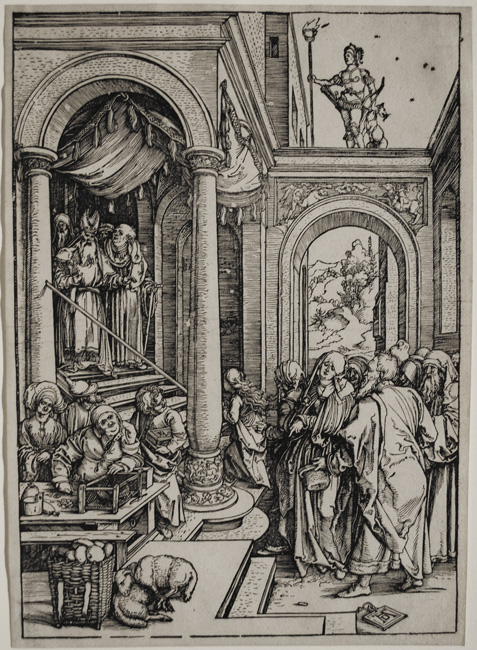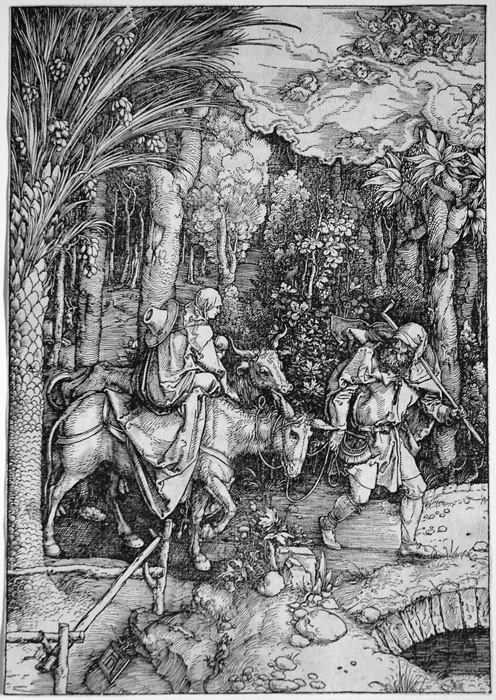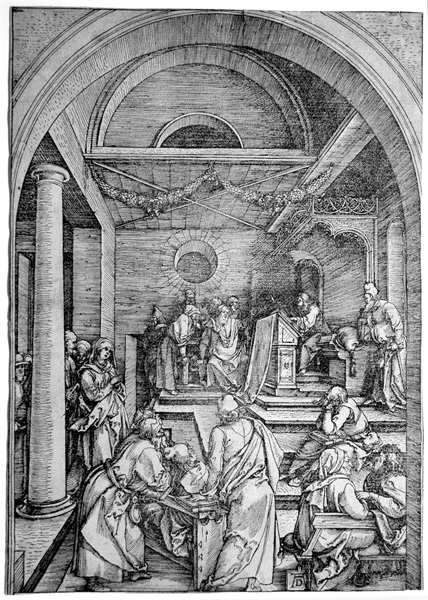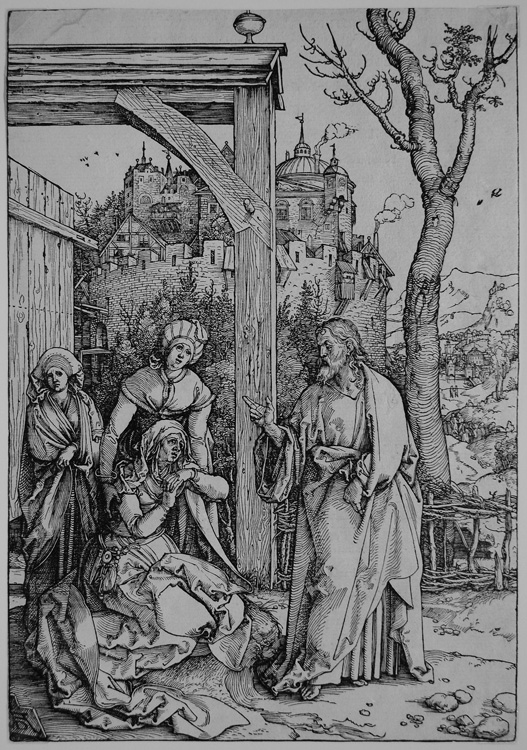Click image for BBB rating
See our Privacy Policy
cool="cool" width="787" height="12658" border="0" cellpadding="0" cellspacing="0" gridx="16" showgridx="showgridx" usegridx="usegridx" gridy="16" showgridy="showgridy" usegridy="usegridy" bgcolor="#99ccff">
|
|
|
 |
|
|
|
|
|
|
Welcome to Spaightwood Galleries, Inc.
120 Main Street, Upton MA 01568-6193
You can follow us on Facebook and Twitter!
We blog regularly on Facebook and announce special events and special sales on both sites.
Old Master Prints: Albrecht Durer (Nuremburg, 1471-1528), The Life of the Virgin
|
|
|
Durer began the Life of the Virgin c. 1501-02 and completed it in 1511, incorporating into it works probably done before Durer decided upon a series of woodcuts, but with an overall plan in mind early on. Strauss suggests that although several of the sheets were done with Schongauer engravings in front of him, Durer never simply imitated but changed and invented anew as he worked. The first complete edition (with a Latin text by Benedictus Chelidonius—who also supplied texts for the Large Woodcut Passion, also published in 1511— printed on the verso of the prints) was published in 1511.
Walter L. Strauss in his catalogue raisonne, Albrecht Durer Woodcuts and Woodblocks (Abaris Books, 1980), provides a summary of comments upon each individual work. Strauss's Commentary volume in the Illustrated Bartsch series updates his commentary here. As always, Panofsky's Life and Art of Albrecht Durer (Princeton University Press, 1945, revised editions culminating in the 1971 edition) is crucial for an understanding of the work of this great artist and printmaker.
|
|
|
|
 |
|
|
Joachim's offering rejected (Bartsch 77, Strauss 94, Meder 19c-d). Original woodcut, 1504. Executed for The Life of the Virgin, this impression from c. 1580 is printed on paper with the Fish Badder watermark. Margins trimmed to or within the image. One of Durer's masterpieces, the print illustrates the high priest rejecting Joachim's offering of a sheep because he and his wife Anna, who are to become the parents of the Virgin Mary, are barren, a sign that they must have been rejected by God. The woodcut chooses a very ironic moment in which the wisdom of man is shortly to become shown to be false. Image size: 294x213mm. Price: Please call or email for current pricing information.
|
|
|
 |
|
|
Joachim and Anna at the Golden Gate (Bartsch 79, Strauss 96, Meder 191). Original woodcut, 1509. Executed for The Life of the Virgin, this impression from the first Latin edition of 1511 is a very good dark and evenly-printed impression witht the shovel with a flower watermark (Meder 127). Margins trimmed on the border line. Strauss calls this print a masterpiece, the high point of The Life of the Virgin Series. With the Latin text. This print is illustrated in almost every book on Durer's work as a printmaker. Image size: 297x204mm. Price: Please call or email for current pricing information 000.
|
|
|
 |
|
|
Presentation of the Virgin in the Temple (Bartsch 81, Strauss 79, Meder 193b). Original woodcut, c. 1503-1504. Executed for The Life of the Virgin, this impression from c. 1572 is printed on paper with the Small Coat of Arms (M. 274, Br. 2327) watermark. Good margins outside the borders. Either "Apollo the Dragon-Slayer" or "Mars" presides top right (Jesus, of course, will be the ultimate dragon-slayer, defeating that "old dragon," Satan, with his death on the cross to satisfy man's debt to God. At the top of the short set of stairs the Virgin is climbing we see the High Priest and several attendants; below them, we see a group of money changers (whom Jesus will expell from the Temple in due course) and two dead lambs for sacrifices until the Lamb of God's sacrifice ends the need for further scarifices. This print is illustrated in almost every book on Durer's work as a printmaker. Image size: 299x210mm. Price: Please call or email for current pricing information.
|
|
|
 |
|
|
Presentation of the Virgin in the Temple (Bartsch 81, Strauss 79, Meder 193g). Original woodcut, c. 1503-1504. Executed for The Life of the Virgin, this impression from c. 1596 is printed on paper with the Double Eagle with flower watermark. Margins trimmed to or within the image. Ours is an impression from what was evidently an edition of the "Life of the Virgin" c. 1596-1600 printed from Durer's woodblocks. Either "Apollo the Dragon-Slayer" or "Mars" presides top right (Jesus, of course, will be the ultimate dragon-slayer, defeating that "old dragon," Satan with his death on the cross to satisfy man's debt to God. At the top of the short set of stairs the Virgin is climbing we see the High Priest and several attendants; below them, we see a group of money changers (whom Jesus will expell from the Temple in due course) and two dead lambs for sacrifices until the Lamb of God's sacrifice ends the need for further scarifices. This print is illustrated in almost every book on Durer's work as a printmaker. Image size: 299x210mm. Price: Please call or email for current pricing information.
|
|
|
 |
|
|
|
The Betrothal of the Virgin (Bartsch 82, Strauss 97, Meder 194). Original woodcut, c. 1504. Executed for The Life of the Virgin, this impression appears to be a very good example of Meder's state c with the Small City Gate watermark (M. 275). c. 1560-1580. The gaps in the borders at bottom seem to have been filled in with ink and there are signs of reinforced horizontal folds from the verso. The event takes place in the interior of the Temple. The bottom half is filled with the actors, Joseph, Mary and the High Priest. Surrounding them are a number of figures (including a woman in a winged headress at left who also appears in a drawing of Durer's with the inscription, "Think of me in your kingdom in 1500; thus attired one goes to Church in Nuremberg" and a man in a top hat seen from the rear at left. At the top of the frame, a large owl, emblem of night, unfolds his wings; in the Gothic sculptural ornaments on the sides of the arch two nude men on unicorns fend off wild women on lions, perhsps symbolizing the repulse of lust by chastity. Meder calls for this print to be "blotchy" and to show gaps in the winged headress and the hem of Joseph's garment, which are not apparent in our print under 10x magnification, so ours may in fact be considerably earlier than the watermark suggests. One of Durer's most frequently illustrated woodcuts. Image size: 296x212mm. Price: Please call or email for current pricing information.
|
|
|
 |
|
|
The Annunciation (Bartsch 83, Strauss 97, Meder 195). Original woodcut, c. 1503. Executed for The Life of the Virgin, this impression appears to be an extremely good example of Meder's state e with the Fish Bladder with IM watermark (M. 309). c. 1580. Some of the details have been much commented upon: Talbot et al (NAtional Gallery of Art, 1971) suggest that the architecture elevates the private meeting between Mary and Gabriel to the level of a majestic reception (Strauss, p. 260). Panofsky suggests that the "The Dove, representing the Holy Spirit, illuminates her face, while God the Father hovers in the distant clouds. The lilies in the vase symbolize purity, whereas Judith with the head of Holofernes, in the timpanum, calls to mind Mary's victory over the devil." Panofsky additionally notes the "The evil one, with the head of a badger, can be discerned underneath the stairs, chained to the wall on the far left. The badger stands for sloth and laziness, which is 'the mother of all sin' " (Panofsky, Dürer, 1943, Vol. 2, Handlist, n. 303). Our impression is bright and clear with the gaps in the border all present as described by Meder, bu tthe gaps at the top border are barely visible. Two small discolorations are visible, one to the left of the lilies at bottom and one in the block to the left of the headstone of the arch. One of Durer's most frequently illustrated woodcuts. Image size: 296x212mm. Price: Please call or email for current pricing information.
|
|
|
|
|
 |
|
|
The Adoration of the Magi (Bartsch 87, Strauss 76, Meder 199). Original woodcut, c. 1503. Executed for The Life of the Virgin, this impression appears to be an example of Meder's state a "Before the text": "precise lines, bright because almost totally devoid of crosshatchings." Following these early proofs, gaps in the border develop, there is a split below the leafy plant lower left (state b, proof before the 1511 Latin edition); after the 1511 edition with the Latin text verso: 2 gaps above the star and one above the angels; 2 gaps on the right, and one on the bottom, etc. Our impression precedes all of these markers of later printings. A lovely impression with only a few skinned spots verso and one small pinhole upper left. This print is illustrated in almost every book on Durer's work as a printmaker. Image size: 296x209mm. Price: Please call or email for current pricing information.
|
|
|
 |
|
|
The Circumcision of Christ (Bartsch 86, Strauss 98, Meder 198). Original woodcut, c. 1505. Executed for The Life of the Virgin, A good, black, and evenly-printed impression after the 1511 Latin text edition with good contrasts and minimal wear except for repaired tears from old hinges. On the left, a man carrying a very large candle pauses to observe the events occury on the right, pulling our eyes toward Jesus's circumcision, his first shedding of blood under the law of Moses. On the right, Joseph turns away while a very youthful Mary prays and grieves for her son's wound (the first of her Seven Sorrows). Strauss observes that "Moses the law-giver and Judith, a pre-figuration of Mary, are pictured in the twining tracery of the background, together with the Lion of Judah, and an infant, symbolic of the Mesiah" (p. 322). Image size: 294x209mm. Price: Please call or email for current pricing information.
|
|
|
 |
|
|
The Flight into Egypt (Bartsch 89, Strauss 92, Meder 201). Original woodcut, c. 1503-1504. Executed for The Life of the Virgin, A good, dark, and evenly-printed impression from the 1511 Latin text edition with strong contrasts and little or no signs of wear. Strauss comments that "the most remarkable aspect of this print is its setting. . . . Durer has here achieved unprecedented 3-dimensionality." This print is illustrated in almost every book on Durer's work as a printmaker. Image size: 300x211mm. Price: SOLD.
|
|
|
 |
|
|
Christ teaching the Doctors (Bartsch 91, Strauss 38, Meder 203). Original woodcut, c. 1503. Executed for The Life of the Virgin, this impression is from the first edition with the poem printed verso. Watermark: Crown over gate or tower. Repaired tears center and right margins, trimmed at bottom (see below for complete image). This print is illustrated in almost every book on Durer's work as a printmaker. One of Durer's masterpieces. Image size: 293x207mm. Price: SOLD.
|
|
|
 |
|
|
Christ teaching the doctors in the Temple (Bartsch 91, Strauss 38, Meder 203). Original woodcut, c. 1503. Executed for The Life of the Virgin, this impression from c. 1580 is printed on paper with the Fish Bladder watermark. Repaired diagonal tear lower left corner. Margins trimmed to or within the image. One of Durer's masterpieces. Image size: 298x210mm. Price: Please call or email for current pricing information.
|
|
|
 |
|
|
Christ taking leave from his Mother (Bartsch 92, Strauss 93, Meder 204). Original woodcut, c. 1504-05. Executed for The Life of the Virgin, this impression picturing Jesus' farewell to his mother before his final journey to Jerusalem is from the 1511 first edition with the Latin text on the verso. Strauss thinks it must date from before Dürer's second Italian journeybecause one of the purposes of that trip was to get the Venetian Senate to stop Marcantonio Raimondi from "stealing" Dürer's work and signing it with Dürer's monogram. Marcantopnio's copy dates from about 1506 and one of Jacob Cornelisz of Amsterdam's copies of Dürer's design dates from c. 1507. Trimmed outside the border line on the sides and the bottom on or just within it on top. A good well-inked impression with strong contrasts. The mostly blank area in the upper left corner has been repaired. Meder says the 1511 edition has 3 small gaps lower right; only 2 are visible on ours, suggesting that ours is a very early impression. One of Durer's masterpieces. Image size: 298x206mm. Price: Please call or email for current pricing information.
|
|
|
 |
|
|
The Glorification of the Virgin (Bartsch 95 Strauss 70, Meder 207). Original woodcut, c. 1502. Although this work is placed as the final sheet in The Life of the Virgin, Strauss suggests that it was probably the earliest one executed and notes that only here is Dürer's monogram (botom center) not placed on a tablet. He also suggests that "it is the first example of Dürer's preoccupation with the intricate perspective of interiors." The scene is quite crowded: at the top, we see Moses with the tablets of the Law, the order into which Jesus was born. Below, the Virgin holds the Infant Christ who looks at the Gospel shown him by an angel while a second angel plays the harp. At the far left, St. Jerome beckons to his lion (partially hidden by a column); St. Paul carrying the sword of his martyrdom as defender of the faith; St. Augustine wearing a bishop's mitre as Bishop of Hippo; St. Anthony carrying his pilgrim's staff; John the Baptist holding a lamb; and St. Joseph, hat in hand, stresses the virginity of the Virgin. In the foreground at left we see St. Catherine with the spiked wheel of her martydom and and a vase of lilies signifying purity. In the immediate foreground, winged putti are playing a flute, catching a rabbit, and holding a pin-wheel and a rattle (see Strauss, p. 240 for more). Our impression is a Meder II f with the two fine vertical cracks in the block upper center to the right of Moses and center to the left of the Virgin's head. Ex-collection of André-Jean Hachette (Lugt 132, verso). One of Durer's masterpieces. Image size: 302x212mm. Price: Please call or email for current pricing information.
|
|
|
|
|
Spaightwood Galleries, Inc.
To purchase, call us at 1-800-809-3343 (1-508-529-2511 in Upton MA & vicinity) or send an email to spaightwood@gmail.com.
We accept AmericanExpress, DiscoverCard, MasterCard, and Visa.
We also accept wire transfers and paypal.
For directions and visiting information, please call. We are, of course, always available over the web and by telephone (see above for contact information). Click the following for links to past shows and artists. For a visual tour of the gallery, please click here. For information about Andy Weiner and Sonja Hansard-Weiner, please click here. For a list of special offers currently available, see Specials.
All works are sold with an unconditional guarantee of authenticity (as described in our website listing).
Go back to the top of this page.
Visiting hours: Saturday 10:00 am to 5:00 pm and Sunday noon to 6:00 pm and other times by arrangement.
Please call to confirm your visit. Browsers and guests are welcome.
|
|
|
|
|
|
|
|
|
|
|
|
|
|
|
|
|
|
|
|
|
|
|
|
|
|
|












